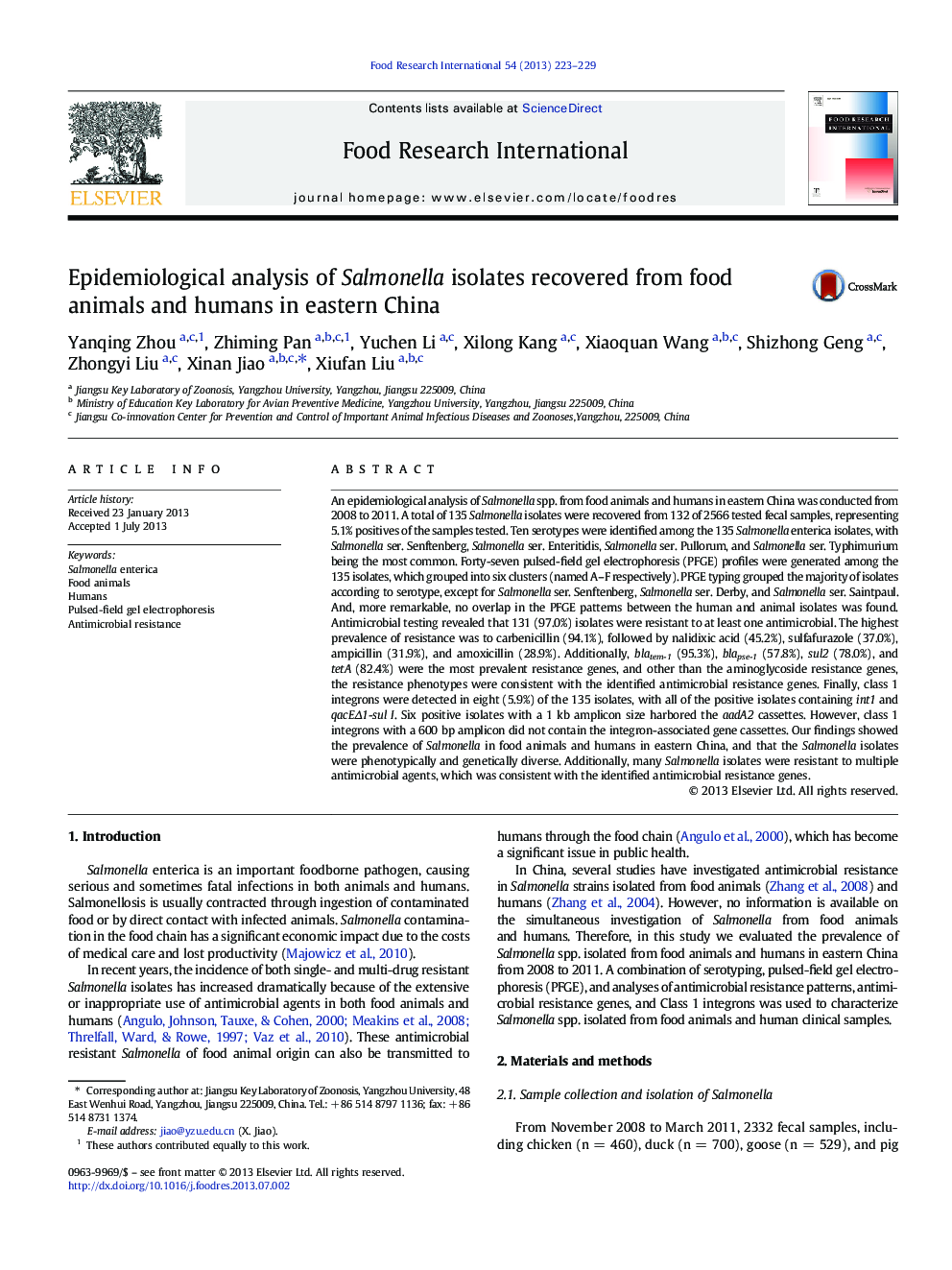| کد مقاله | کد نشریه | سال انتشار | مقاله انگلیسی | نسخه تمام متن |
|---|---|---|---|---|
| 6397228 | 1330674 | 2013 | 7 صفحه PDF | دانلود رایگان |
عنوان انگلیسی مقاله ISI
Epidemiological analysis of Salmonella isolates recovered from food animals and humans in eastern China
ترجمه فارسی عنوان
تجزیه و تحلیل اپیدمیولوژیک جدایی های سالمونلا از حیوانات و انسان های مواد غذایی در شرق چین است
دانلود مقاله + سفارش ترجمه
دانلود مقاله ISI انگلیسی
رایگان برای ایرانیان
موضوعات مرتبط
علوم زیستی و بیوفناوری
علوم کشاورزی و بیولوژیک
دانش تغذیه
چکیده انگلیسی
An epidemiological analysis of Salmonella spp. from food animals and humans in eastern China was conducted from 2008 to 2011. A total of 135 Salmonella isolates were recovered from 132 of 2566 tested fecal samples, representing 5.1% positives of the samples tested. Ten serotypes were identified among the 135 Salmonella enterica isolates, with Salmonella ser. Senftenberg, Salmonella ser. Enteritidis, Salmonella ser. Pullorum, and Salmonella ser. Typhimurium being the most common. Forty-seven pulsed-field gel electrophoresis (PFGE) profiles were generated among the 135 isolates, which grouped into six clusters (named A-F respectively). PFGE typing grouped the majority of isolates according to serotype, except for Salmonella ser. Senftenberg, Salmonella ser. Derby, and Salmonella ser. Saintpaul. And, more remarkable, no overlap in the PFGE patterns between the human and animal isolates was found. Antimicrobial testing revealed that 131 (97.0%) isolates were resistant to at least one antimicrobial. The highest prevalence of resistance was to carbenicillin (94.1%), followed by nalidixic acid (45.2%), sulfafurazole (37.0%), ampicillin (31.9%), and amoxicillin (28.9%). Additionally, blatem-1 (95.3%), blapse-1 (57.8%), sul2 (78.0%), and tetA (82.4%) were the most prevalent resistance genes, and other than the aminoglycoside resistance genes, the resistance phenotypes were consistent with the identified antimicrobial resistance genes. Finally, class 1 integrons were detected in eight (5.9%) of the 135 isolates, with all of the positive isolates containing int1 and qacEÎ1-sul I. Six positive isolates with a 1Â kb amplicon size harbored the aadA2 cassettes. However, class 1 integrons with a 600Â bp amplicon did not contain the integron-associated gene cassettes. Our findings showed the prevalence of Salmonella in food animals and humans in eastern China, and that the Salmonella isolates were phenotypically and genetically diverse. Additionally, many Salmonella isolates were resistant to multiple antimicrobial agents, which was consistent with the identified antimicrobial resistance genes.
ناشر
Database: Elsevier - ScienceDirect (ساینس دایرکت)
Journal: Food Research International - Volume 54, Issue 1, November 2013, Pages 223-229
Journal: Food Research International - Volume 54, Issue 1, November 2013, Pages 223-229
نویسندگان
Yanqing Zhou, Zhiming Pan, Yuchen Li, Xilong Kang, Xiaoquan Wang, Shizhong Geng, Zhongyi Liu, Xinan Jiao, Xiufan Liu,
